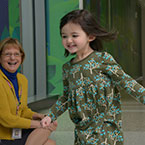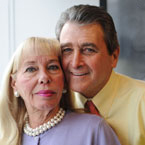Early Detection of SCID Saves Lives
Needle in a Haystack
We brought a newborn screening test to Washington to catch a rare disorder when babies are still healthy enough to be cured.
When Rachel and Zach Dixon’s son Ezra was born, he looked and acted like the perfect, healthy baby every parent hopes for. Three days later, the Dixons’ pediatrician called to tell them Ezra tested positive for severe combined immunodeficiency (SCID), a life-threatening condition that left him unable to fight infections.
“We were in disbelief — it was just a matter of time before he got really sick,” Dixon remembers.
Four days later at Seattle Children’s, Drs. Suzanne Skoda-Smith and Troy Torgerson confirmed the diagnosis – and told the Dixons that Ezra was the first baby detected by a screening test for SCID that Seattle Children’s and the Washington State Department of Newborn Screening spent years bringing to Washington state.
Babies don’t usually show signs of the disease until age four to six months,when the mother’s antibodies wear off and the baby gets a serious infection.
“Once newborns get sick, their long-term survival rate drops to around 50% because they are too weak to do well during a stem cell transplant, which is the most common treatment,” Skoda-Smith says. “Because the newborn screening test caught Ezra when he was still healthy, we knew we could almost certainly cure him. It was one of the most exciting days of my career.”
“Because the newborn screening test caught Ezra when he was still healthy, we knew we could almost certainly cure him. It was one of the most exciting days of my career.”
Can cures be too costly?
SCID affects one in about 40,000 babies. It was featured in the 1976 movie The Boy in the Plastic Bubble, in which John Travolta played a patient confined to a bubble that blocked out germs. But “bubble-boy disease” is a misnomer — stem cell transplants in newborns younger than three and a half months can cure SCID about 94% of the time, according to a study in the New England Journal of Medicine that Skoda-Smith and Dr. Lauri Burroughs contributed to.
“The key is to catch SCID before babies get ill,” Skoda-Smith says.
Every baby born in Washington is screened for about two dozen serious health problems, giving doctors a chance to identify babies with those problems and deliver treatment early, when it can prevent complications and save lives. About five years ago, Skoda-Smith and Torgerson proposed that the state’s screening lab add testing for SCID.
“They were immediately on board, but they didn’t have the equipment or expertise to do the SCID test — or the funding to pay for it,” Torgerson says.
Still, Michael Glass, who directed the state lab at the time, was determined to bring SCID screening to Washington. The test increases screening costs by about $8 per patient (approximately 8%). Glass started the political process to add funding to the governor’s budget while his staff figured out how to conduct the test.
“The state lab folks visited our lab and labs in Wisconsin, Massachusetts and New York to see how other states do SCID screening,” Skoda-Smith says. “Then they developed a terrific test of their own.”
Testifying for change

Because severe combined immunodeficiency (SCID) was not yet on the Washington state newborn screening panel, Eliana was not diagnosed until she became ill. Children like Eliana and her sister Madalena (on the far right) inspire the work of pediatricians like Dr. Suzanne Skoda-Smith to make newborn screening for SCID available and to improve treatment options.
Skoda-Smith, Torgerson and families affected by SCID went to Olympia over and over again to make their case for the test and the extra funding. They got help from a key ally: the Jeffrey Modell Foundation, which was started by Vicki and Fred Modell in 1987 after their 15-year-old son, Jeffrey, died of complications from immunodeficiency.
One mission of the foundation is to make SCID screening part of every newborn’s care, and it has given several states startup funds for the tests. The foundation also provides key funding to Seattle Children’s Immunology Diagnostic Laboratory to help physicians around the world diagnose immune disorders and figure out the best way to treat them.
Fred Modell testified to Washington state’s Newborn Screening Advisory Committee in 2012 and read the committee a letter from a parent who said their son would be alive if he had been born in a state that screened for SCID.
“It doesn’t make sense to do nothing and let these babies die when you can screen, diagnose and potentially cure them,” Modell says.
Legislators worried that Medicaid and insurance companies would suffer if they had to pay hundreds of thousands of dollars for stem cell transplants. Skoda-Smith and Torgerson explained that children need rigorous treatment even when SCID is detected later.
“Sometimes, those kids spend months in the ICU and never recover,” Skoda-Smith says. “It costs more than a transplant and you miss your chance to save them.”
The legislature approved funding for the screening last October, making Washington one of about 30 states that currently test newborns for SCID. The state lab expects to identify one or two newborns with SCID per year, plus about a dozen children with less serious immune disorders.
Making transplants safer

After losing their son Jeffrey, Vicki and Fred Modell created the Jeffrey Modell Foundation to improve diagnosis, treatment and awareness of primary immunodeficiency.
Like Ezra, the newborns identified will be referred to Seattle Children’s Pediatric Blood and Marrow Transplant Program. The program brings together experts from Seattle Children’s, UW Medicine and Fred Hutchinson Cancer Research Center, where Burroughs and her colleagues are developing ways to make stem cell transplants even safer and more effective.
The Dixons enrolled Ezra in a clinical trial of an approach that uses two chemotherapy drugs, treosulfan and fludarabine phosphate, to get the body ready to accept new stem cells. This combination is less toxic than the traditional approach and potentially easier for babies to withstand. Burroughs leads the trial, and Seattle Children’s is one of only two places where patients can enroll in it.
The FDA is evaluating treosulfan for approval, and Burroughs envisions her approach becoming standard treatment for nonmalignant diseases.
“About 90% of patients with nonmalignant diseases in our trial have survived transplant, which is a huge improvement for babies and children who might otherwise not have much of a chance,” she says.
Even with the milder chemotherapy, Ezra developed a rash that covered his body. He had gastrointestinal sores that made eating painful, and doctors had to feed him through a tube. He underwent a bone marrow transplant when he was 9 weeks old, thanks to cells donated by his 2-year-old brother Judah.
The cells engrafted into Ezra’s body within two weeks. Now nearly 1 year old, Ezra is a happy baby. His doctors expect him to be at full strength by summer.
“Before Ezra, I was always busy planning and worrying about the future,” Rachel Dixon says. “Now we cherish each moment.”
Published in Connection magazine, Spring 2015